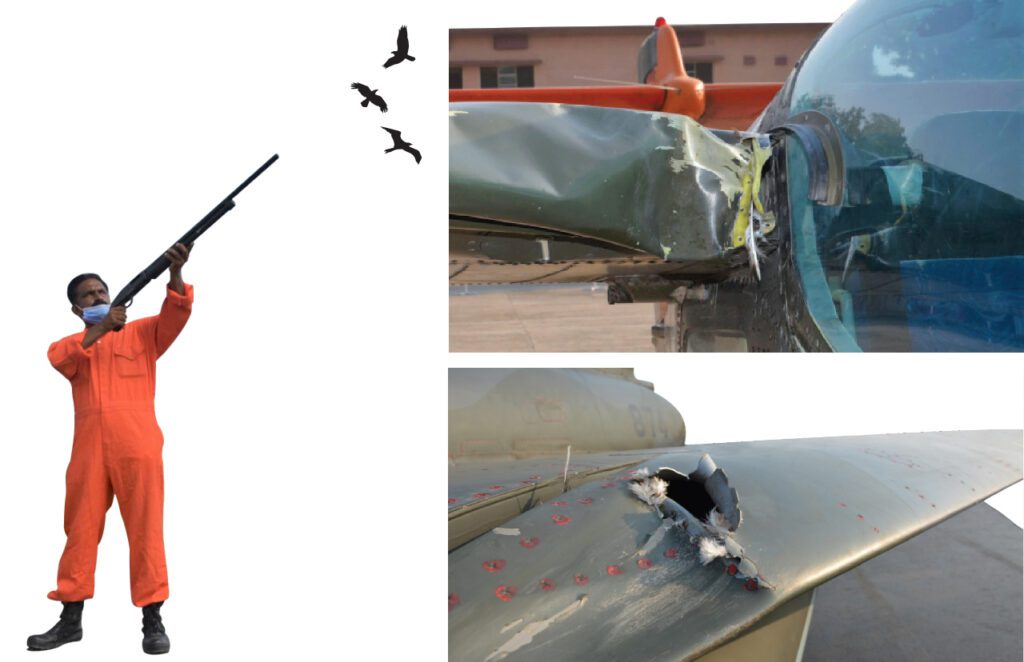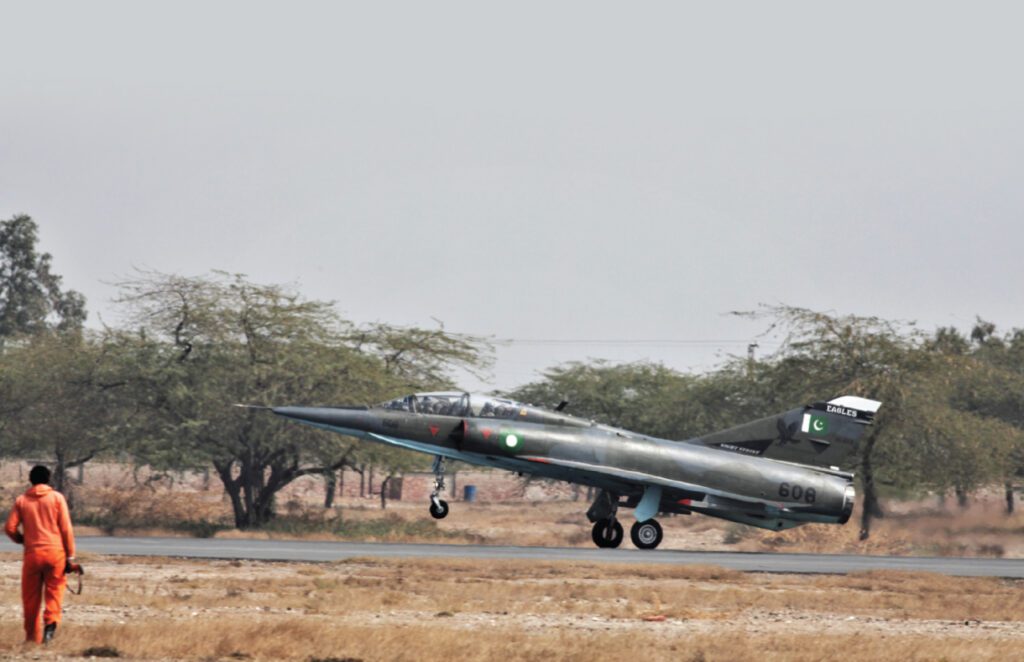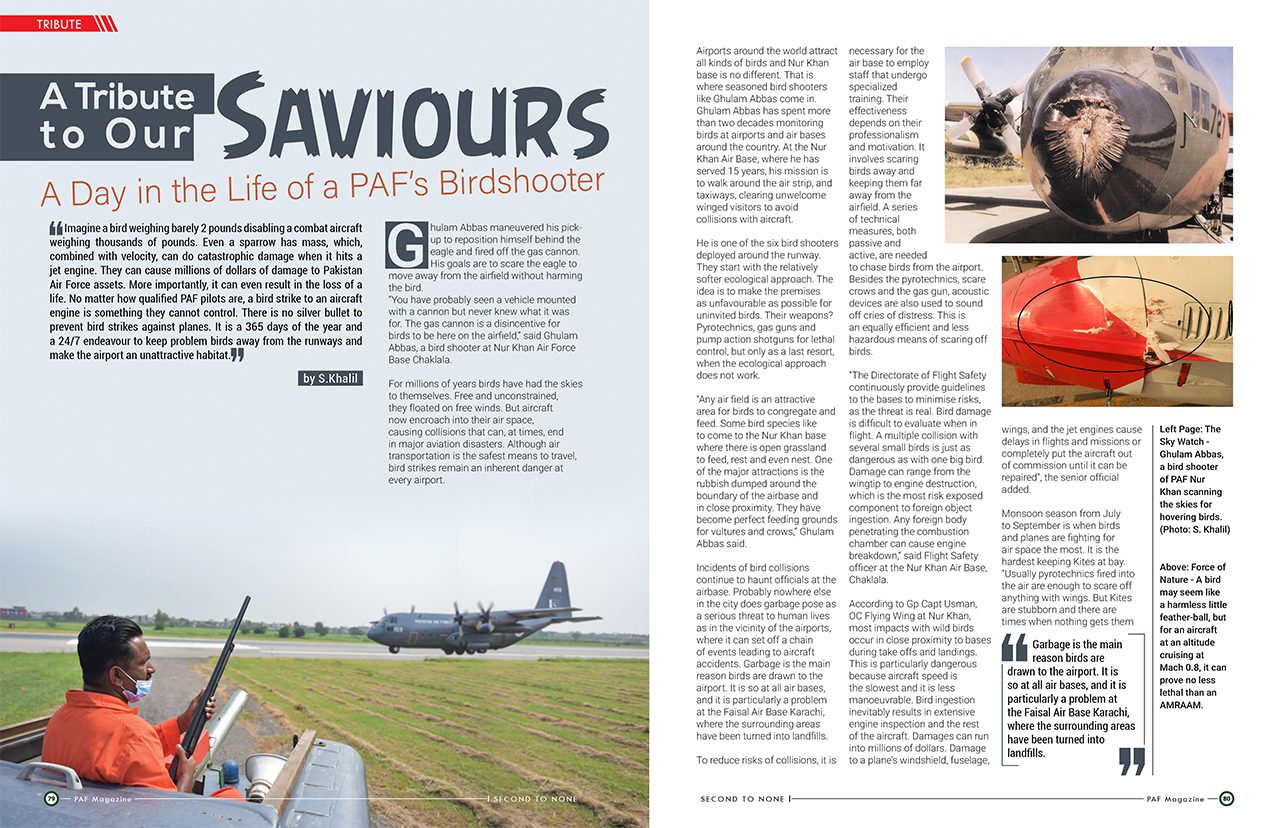A Day in the Life of a PAF’s Birdshooter
Imagine a bird weighing barely 2 pounds disabling a combat aircraft weighing thousands of pounds. Even a sparrow has mass, which, combined with velocity, can do catastrophic damage when it hits a jet engine. They can cause millions of dollars of damage to Pakistan Air Force assets. More importantly, it can even result in the loss of a life. No matter how qualified PAF pilots are, a bird strike to an aircraft engine is something they cannot control. There is no silver bullet to prevent bird strikes against planes. It is a 365 days of the year and a 24/7 endeavour to keep problem birds away from the runways and make the airport an unattractive habitat.
Ghulam Abbas maneuvered his pick-up to reposition himself behind the eagle and fired off the gas cannon. His goals are to scare the eagle to move away from the airfield without harming the bird.
“You have probably seen a vehicle mounted with a cannon but never knew what it was for. The gas cannon is a disincentive for birds to be here on the airfield,” said Ghulam Abbas, a bird shooter at Nur Khan Air Force Base Chaklala.
For millions of years birds have had the skies to themselves. Free and unconstrained, they floated on free winds. But aircraft now encroach into their air space, causing collisions that can, at times, end in major aviation disasters. Although air transportation is the safest means to travel, bird strikes remain an inherent danger at every airport.
Airports around the world attract all kinds of birds and Nur Khan base is no different. That is where seasoned bird shooters like Ghulam Abbas come in. Ghulam Abbas has spent more than two decades monitoring birds at airports and air bases around the country. At the Nur Khan Air Base, where he has served 15 years, his mission is to walk around the air strip, and taxiways, clearing unwelcome winged visitors to avoid collisions with aircraft.
He is one of the six bird shooters deployed around the runway. They start with the relatively softer ecological approach. The idea is to make the premises as unfavourable as possible for uninvited birds. Their weapons? Pyrotechnics, gas guns and pump action shotguns for lethal control, but only as a last resort, when the ecological approach does not work.

“Any air field is an attractive area for birds to congregate and feed. Some bird species like to come to the Nur Khan base where there is open grassland to feed, rest and even nest. One of the major attractions is the rubbish dumped around the boundary of the airbase and in close proximity. They have become perfect feeding grounds for vultures and crows,” Ghulam Abbas said.
Incidents of bird collisions continue to haunt officials at the airbase. Probably nowhere else in the city does garbage pose as a serious threat to human lives as in the vicinity of the airports, where it can set off a chain of events leading to aircraft accidents. Garbage is the main reason birds are drawn to the airport. It is so at all air bases, and it is particularly a problem at the Faisal Air Base Karachi, where the surrounding areas have been turned into landfills.
To reduce risks of collisions, it is necessary for the air base to employ staff that undergo specialized training. Their effectiveness depends on their professionalism and motivation. It involves scaring birds away and keeping them far away from the airfield. A series of technical measures, both passive and active, are needed to chase birds from the airport. Besides the pyrotechnics, scare crows and the gas gun, acoustic devices are also used to sound off cries of distress. This is an equally efficient and less hazardous means of scaring off birds.
“The Directorate of Flight Safety continuously provide guidelines to the bases to minimise risks, as the threat is real. Bird damage is difficult to evaluate when in flight. A multiple collision with several small birds is just as dangerous as with one big bird. Damage can range from the wingtip to engine destruction, which is the most risk exposed component to foreign object ingestion. Any foreign body penetrating the combustion chamber can cause engine breakdown,” said Flight Safety officer at the Nur Khan Air Base, Chaklala.
According to Gp Capt Usman, OC Flying Wing at Nur Khan, most impacts with wild birds occur in close proximity to bases during take offs and landings. This is particularly dangerous because aircraft speed is the slowest and it is less manoeuvrable. Bird ingestion inevitably results in extensive engine inspection and the rest of the aircraft. Damages can run into millions of dollars. Damage to a plane’s windshield, fuselage, wings, and the jet engines cause delays in flights and missions or completely put the aircraft out of commission until it can be repaired”, the senior official added.
Monsoon season from July to September is when birds and planes are fighting for air space the most. It is the hardest keeping Kites at bay. “Usually pyrotechnics fired into the air are enough to scare off anything with wings. But Kites are stubborn and there are times when nothing gets them going. They sit in the centre of the runway and do not budge despite all the scare tactics and abatement systems. We are left with no choice but to shoot them,” Ghulam Abbas said.
Ghulam Abbas prefers not to kill crows, which are also plenty around the airstrip. “Crows are quite intelligent. They keep their distance and cannot be easily deterred. And when we do have to kill one, dozens more gather to mourn, creating an even bigger problem,” he said.
This is a fairly light day for Abbas, so aircraft operations at Nur Khan air base continue without interruption. But the inventory of species in and around the airport sites increases during winters. Besides the eagles and crows, the ground crews become concerned about migratory birds running into aircraft engines or when they perch on antennas that can cause interference with pilot instruments. October, April and May become equally busy months, when migratory patterns bring from the chilling North more unwanted birds through the base’s airspace.
Keeping the runway as bird free as possible is not all they do to help keep our aircraft up in the sky and our pilots safe. Bird shooters are the eyes and ears of the control tower on the airstrip, men who give the final clearance.
In one particular incident at the Sumungli Air Base, home to the No 23 and No 17 squadrons, where Ghulam Abbas started working initially, it was business as usual. Ghulam Abbas, who was standing at the end of the runway, spotted a leak from the fuel tank of an F-7 jet readying for take-off.

“I immediately informed the control tower about the anomaly and the flight was aborted. The pilot was grateful and I felt satisfied” Ghulam Abbas said.
Similarly, on Basant earlier in March at Chaklala, a kite got caught in the wingtip of an aircraft that neither the control tower nor the pilot noticed. It was the bird shooter at the end of the runway who radioed the control tower, which informed the captain of the plane, Ghulam Abbas said. Several such incidents were reported where only the bird shooters spotted something and warned the control tower and the pilots that saved their lives and loss of aircraft.
Bird shooters are an important part of a vigorous flight-safety program that enables the PAF to accomplish our missions of transporting crew and supplies across the country.
“We are the men with the final word. In our business, it’s all about mission capability,” the bird shooter said dressed in his orange overall. It’s a sunrise to sunset job for Ghulam Abbas. He wishes there were fewer stray dogs and birds around the airbase. While the bird shooter is doing his bit to keep pilots and millions of dollars worth of the country’s assets safe, he wishes people will also realise their responsibilities and do not litter.
“Know that everytime people toss a wrapper out onto the road around airstrips, it puts a pilot’s life at high risk. It is the last thing to see a catastrophe caused by a bird strike. Together we need to help support air force missions and make flying a lot safer,” he urged.
Nonetheless, for Ghulam Abbas who clocks in around 6 am, it’s a ceaseless job of uninterrupted surveillance to make the air base inhospitable for birds and minimize bird-aircraft collision. He finds himself where very few people are allowed to go, and that’s the infield of a major air force base.
“It is satisfying to almost immediately see the results of your work. We use these various harassment tools to minimize habituation and the element of surprise is maximized. At the time of take-off or landing, when you see the birds fly away from the airfield due to your efforts, your job is done….you feel satisfied” he said.








